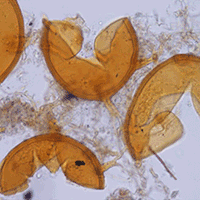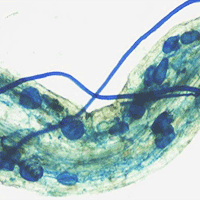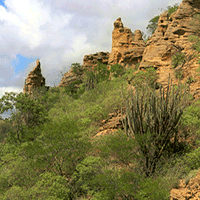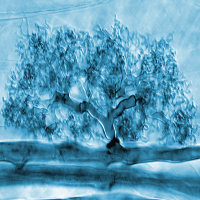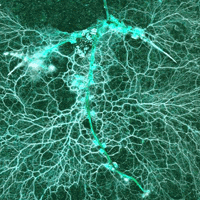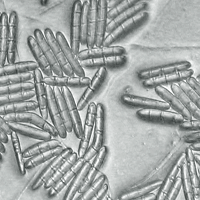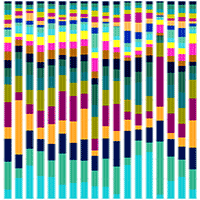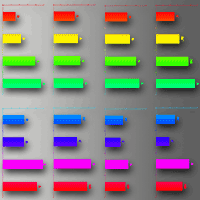Betula alnoides is a fast-growing and native timber species prevalently planted in tropical and subtropical areas of southern China. Despite the large-scale development of B. alnoides plantations, knowledge of its association with arbuscular mycorrhizal fungi (AMF) is limited. In the present study, we chose young (3-year-old sapling, P3y) and middle-aged (12-year-old stand, P12y) B. alnoides plantations and adjacent native forest (N) in the Puwen Tropical Forest Experimental Station located in Xishuangbanna prefecture of Yunnan Province, southwestern China, as study materials and explored the change in AMF community composition in the plantation chronosequence. In addition, we combined morphological methods and Illumina MiSeq sequencing techniques to analyze rhizosphere soil AMF. The results indicated that the AMF richness and diversity indexes of B. alnoides at two ages tended to be similar to those of natural growing trees in native forest. However, the specific AM fungal compositions were distinctly different, providing evidence of the conservation value of the native forest, which harbors a unique AMF diversity. Hierarchical cluster analysis further revealed that the AMF community composition of trees in the mid-aged stand (P12y) was more similar to that of naturally growing B. alnoides (N) than that of the young-aged trees (P3y), which proved the considerable resilience of AMF to the establishment of the B. alnoides plantation. A set of at least five soil properties (available phosphorus, available nitrogen, organic matter, total nitrogen and silt content) was found to play a significant role in shaping the AMF communities. These results contribute to the understanding of the impacts of B. alnoides plantations on AMF diversity and composition. Such information is critical for the efficient planting and sustainable management of B. alnoides plantations.
Keywords
, , ,
Citation
Jing Y, Li T, Cui H, Li L, Allen Samuel C, Chen L, Li Y, Zhao Z (2020). Shifts in the arbuscular mycorrhizal fungal community composition of Betula alnoides along young, middle-aged plantation and adjacent natural forest. iForest 13: 447-455. - doi: 10.3832/ifor3515-013
Academic Editor
Werther Guidi Nissim
Paper history
Received: May 15, 2020
Accepted: Aug 04, 2020
First online: Oct 07, 2020
Publication Date: Oct 31, 2020
Publication Time: 2.13 months
© SISEF - The Italian Society of Silviculture and Forest Ecology 2020
Open Access
This article is distributed under the terms of the Creative Commons Attribution-Non Commercial 4.0 International (https://creativecommons.org/licenses/by-nc/4.0/), which permits unrestricted use, distribution, and reproduction in any medium, provided you give appropriate credit to the original author(s) and the source, provide a link to the Creative Commons license, and indicate if changes were made.

Breakdown by View Type
(Waiting for server response...)
Article Usage
Total Article Views: 37314
(from publication date up to now)
Breakdown by View Type
HTML Page Views: 31348
Abstract Page Views: 2878
PDF Downloads: 2429
Citation/Reference Downloads: 0
XML Downloads: 659
Web Metrics
Days since publication: 1894
Overall contacts: 37314
Avg. contacts per week: 137.91
Article Citations
Article citations are based on data periodically collected from the Clarivate Web of Science web site
(last update: Mar 2025)
Total number of cites (since 2020): 8
Average cites per year: 1.33
Publication Metrics
by Dimensions ©
Articles citing this article
List of the papers citing this article based on CrossRef Cited-by.
(1)
Antunes PM, Koch AM, Morton JB, Rillig MC, Klironomos JN (2011)Evidence for functional divergence in arbuscular mycorrhizal fungi from contrasting climatic origins. New Phytologist 189: 507-514.
CrossRef |
Gscholar
(2)
Bever JD, Morton JB, Antonovics J, Schultz PA (1996)Host-dependent sporulation and species diversity of arbuscular mycorrhizal fungi in a mown grassland. Journal of Ecology 84: 71-82.
CrossRef |
Gscholar
(3)
Birhane E, Fatumah N, Gidey K, Zenebe A, Mohammed S (2018)Vegetation cover density and disturbance affected arbuscular mycorrhiza fungi spore density and root colonization in a dry Afromontane forest, northern Ethiopia. Journal of Forestry Research 29: 675-686.
CrossRef |
Gscholar
(4)
Blaszkowski J, Chwat G, Bence Góralska K A (2015)Acaulospora ignota and
Claroideoglomus hanlinii, two new species of arbuscular mycorrhizal fungi (Glomeromycota) from Brazil and Cuba. Mycological Progress 14: 18.
CrossRef |
Gscholar
(5)
Brundrett MC, Tedersoo L (2018)Evolutionary history of mycorrhizal symbioses and global host plant diversity. New Phytologist 220: 1108-1115.
CrossRef |
Gscholar
(6)
Cao M, Zou XM, Warren M, Zhu H (2006)Tropical forests of Xishuangbanna, China. Biotropica 38: 306-309.
CrossRef |
Gscholar
(7)
Chagnon PL, Bradley RL, Maherali H, Klironomos JN (2013)A trait-based framework to understand life history of mycorrhizal fungi. Trends in Plant Science 18: 484-491.
CrossRef |
Gscholar
(8)
Chen HW, Li J, Zhou B, Feng X, Meng M, Liu YG, Wang DM (2006)Comparison of community characteristics between artificial
Betula alnoides forest and mountainous rain forest in Xishuangbanna of Yunnan Province, Chinese Bulletin of Botany 23: 169-176. [in Chinese with English Abstract]
CrossRef |
Gscholar
(9)
Da Silva DKA, De Souza RG, De Alencar Velez BA, Da Silva GA, Oehl F, Maia LC (2015)Communities of arbuscular mycorrhizal fungi on a vegetation gradient in tropical coastal dunes. Applied Soil Ecology 96: 7-17.
CrossRef |
Gscholar
(10)
De Pontes JS, Oehl F, Pereira CD, De Toledo Machado CT, Coyne D, Da Silva DKA, Maia LC (2017)Diversity of arbuscular mycorrhizal fungi in the Brazilian’s Cerrado and in soybean under conservation and conventional tillage. Applied Soil Ecology 117-118: 178-189.
CrossRef |
Gscholar
(11)
Diop TA, Gueye M, Dreyfus BL, Plenchette C, Strullu DG (1994)Indigenous arbuscular mycorrhizal fungi associated with
Acacia albida Del. in different areas of Senegal. Applied and Environmental Microbiology 60: 3433-3436.
CrossRef |
Gscholar
(12)
Du S, Gao XZ, Ma CB, Shen T, Bai YL, Ye DX, Zhu L, Sun Z, Guan YY, Jiang RF, Li K, Yang F, Yang SY, Zhang YF, Su YH, Shao H, Quan WJ (2006)Technical specification for soil analysis. China Agriculture Press, Beijing, pp. 256.
Gscholar
(13)
Duarte LM, Bertini SCB, Stürmer SL, Lambais MR, Azevedo LCB (2019)Arbuscular mycorrhizal fungal communities in soils under three phytophysiognomies of the Brazilian Atlantic Forest. Acta Botanica Brasilica 33: 50-60.
CrossRef |
Gscholar
(14)
Gerdemann JW, Nicolson TH (1963)Spores of mycorrhizal
Endogone species extracted from soil by wet sieving and decanting. Transactions of the British Mycological Society 46: 235-244.
CrossRef |
Gscholar
(15)
Gong MQ, Wang FZ, Chen Y, Chen YL (2000)Mycorrhizal dependency and inoculant effects on the growth of
Betula alnoides seedlings. Forest Research 13: 8-14. [in Chinese with English Abstract]
CrossRef |
Gscholar
(16)
Goslee SC, Urban DL (2007)The ecodist package for dissimilarity-based analysis of ecological data. Journal of Statistical Software 22: 1-19.
CrossRef |
Gscholar
(17)
Guo YJ, Han JG (2008)Soil biochemical properties and arbuscular mycorrhizal fungi as affected by afforestation of rangelands in northern China. Journal of Arid Environments 72: 1690-1697.
CrossRef |
Gscholar
(18)
Hansen MC, Potapov PV, Moore R, Hancher M, Turubanova SA, Tyukavina A, Thau D, Stehman SV, Goetz SJ, Loveland TR, Kommareddy A, Egorov A, Chini L, Justice CO, Townshend JRG (2013)High-resolution global maps of 21st-century forest cover change. Science 342: 850-853.
CrossRef |
Gscholar
(19)
Haug I, Wubet T, Weiß M, Aguirre N, Weber M, Günter S, Kottke I (2010)Species-rich but distinct arbuscular mycorrhizal communities in reforestation plots on degraded pastures and in neighboring pristine tropical mountain rain forest. Tropical Ecology 51: 125-148.
CrossRef |
Gscholar
(20)
Herrmann L, Lesueur D, Bräu L, Davison J, Jairus T, Robain H, Robin A, Vasar M, Wiriyakitnateekul W, Opik M (2016)Diversity of root-associated arbuscular mycorrhizal fungal communities in a rubber tree plantation chronosequence in Northeast Thailand. Mycorrhiza 26: 863-877.
CrossRef |
Gscholar
(21)
Jacobs DF, Oliet JA, Aronson J, Bolte A, Bullock JM, Donoso PJ, Landhäusser SM, Madsen P, Peng SL, Rey-Benayas JM, Weber JC (2015)Restoring forests: what constitutes success in the twenty-first century? New Forest 46 (5-6): 601-604.
CrossRef |
Gscholar
(22)
Jiang YD, Zhou FL, Zhou Y, Chen HW, Zhang KF, Liu YG, Li J (1999)Study on change law of soil nutrient content in
Betula alnoides plantation. Yunnan Forestry Science and Technology 87: 27-31. [in Chinese with English Abstract]
Gscholar
(23)
Júnior PP, Moreira BC, Da Silva MDCS, Veloso TGR, Stürmer SL, Fernandes RBA, Mendonça EDS, Kasuya MCM (2019)Agroecological coffee management increases arbuscular mycorrhizal fungi diversity, PLoS One 14: e0209093.
CrossRef |
Gscholar
(24)
Lee J, Lee S, Young JPW (2008)Improved PCR primers for the detection and identification of arbuscular mycorrhizal fungi. FEMS Microbiology Ecology 65: 339-349.
CrossRef |
Gscholar
(25)
Li J, Chen HW, Feng X (2003)Carbon stock and rate of carbon sequestration assessment of hardwood plantations in tropical Yunnan, China. Guihaia 23: 294-298. [in Chinese with English Abstract]
CrossRef |
Gscholar
(26)
Lin XG, Feng YZ, Zhang HY, Chen RR, Wang JH, Zhang JB, Chu HY (2012)Long-term balanced fertilization decreases arbuscular mycorrhizal fungal diversity in an arable soil in North China revealed by 454 pyrosequencing. Environmental Science and Technology 46: 5764-5771.
CrossRef |
Gscholar
(27)
Liu M, Zheng R, Bai SL, Bai Y, Wang JG (2017)Slope aspect influences arbuscular mycorrhizal fungus communities in arid ecosystems of the Daqingshan Mountains, Inner Mongolia, North China. Mycorrhiza 27: 189-200.
CrossRef |
Gscholar
(28)
Lumini E, Orgiazzi A, Borriello R, Bonfante P, Bianciotto V (2010)Disclosing arbuscular mycorrhizal fungal biodiversity in soil through a land-use gradient using a pyrosequencing approach. Environmental Microbiology 12: 2165-2179.
CrossRef |
Gscholar
(29)
McGonigle TP, Miller MH, Evans DG, Fairchild GL, Swan JA (1990)A new method which gives an objective measure of colonization of roots by vesicular-arbuscular mycorrhizal fungi. New Phytologist 115: 495-501.
CrossRef |
Gscholar
(30)
Melo CD, Luna S, Krüger C, Walker C, Mendonça D, Fonseca HMAC, Jaizme-Vega M, Machado ADC (2017)Arbuscular mycorrhizal fungal community composition associated with
Juniperus brevifolia in native Azorean forest. Acta Oecologica 79: 48-61.
CrossRef |
Gscholar
(31)
Meng M, Chen HW, Liu YG, Feng X, Wang DM, Li LF, Zhou Y (2002)Water conservation function of
Betula alnoides and
Paramichelia baillonii plantations of Xishuangbanna. Yunnan Forestry Science and Technolgy 100: 46-49. [in Chinese with English Abstract]
Gscholar
(32)
Oksanen J, Blanchet GF, Kindt R, Legendre P, Minchin PR, O’Hara RB, Simpson GL, Solymos P, Stevens HH, Wagner H (2013)vegan: community ecology package. R Package Version 2.0.10.
Online |
Gscholar
(33)
Opik M, Vanatoa A, Vanatoa E, Moora M, Davison J, Kalwij JM, Reier U, Zobel M (2010)The online database Maarj AM reveals global and ecosystemic distribution patterns in arbuscular mycorrhizal fungi (Glomeromycota). New Phytologist 188: 223-241.
CrossRef |
Gscholar
(34)
Pagano MC, Utida MK, Gomes EA, Marriel IE, Cabello MN, Scotti MR (2011)Plant-type dependent changes in arbuscular mycorrhizal communities as soil quality indicator in semi-arid Brazil. Ecological Indicators 11: 643-650.
CrossRef |
Gscholar
(35)
Pagano MC, Zandavalli RB, Araújo FS (2013)Biodiversity of arbuscular mycorrhizas in three vegetational types from the semiarid of Ceará State, Brazil. Applied Soil Ecology 67: 37-46.
CrossRef |
Gscholar
(36)
Pereira APDA, Santana MC, Bonfim JA, Mescolotti DDL, Cardoso EJBN (2018)Digging deeper to study the distribution of mycorrhizal arbuscular fungi along the soil profile in pure and mixed
Eucalyptus grandis and
Acacia mangium plantations. Applied Soil Ecology 128: 1-11.
CrossRef |
Gscholar
(37)
Redecker D, Schüler A, Stockinger H, Stürmer SL, Morton J, Walker C (2013)An evidence-based consensus for the classification of arbuscular mycorrhizal fungi (Glomeromycota). Mycorrhiza 23: 515-531.
CrossRef |
Gscholar
(38)
Reyes HA, Ferreira PFA, Silva LC, Da Costa MG, Nobre CP, Gehring C (2019)Arbuscular mycorrhizal fungi along secondary forest succession at the eastern periphery of Amazonia: seasonal variability and impacts of soil fertility. Applied Soil Ecology 136: 1-10.
CrossRef |
Gscholar
(39)
Rillig MC, Mummey DL (2006)Mycorrhizas and soil structure. New Phytologist 171: 41-53.
CrossRef |
Gscholar
(40)
Schenck NC, Pérez Y (1990)Manual for the identification of VA mycorrhizal fungi. Synergistic Publications, Gainesville, USA, pp. 283.
Gscholar
(41)
Sheng M, Chen XD, Zhang XL, Hamel C, Cui XW, Chen J, Chen H, Tang M (2017)Changes in arbuscular mycorrhizal fungal attributes along a chronosequence of black locust (
Robinia pseudoacacia) plantations can be attributed to the plantation-induced variation in soil properties. Science of the Total Environment 599- 600: 273-283.
CrossRef |
Gscholar
(42)
Singer M J, Janitzky P (1986)Field and Laboratory procedures used in a soil chronosequence study. USGS Bulletin 1648, US Government Printing Office, Washington, DC, USA, pp. 49.
Online |
Gscholar
(43)
Smith SE, Read D (2008)Mycorrhizal Symbiosis (3rd edn). Academic Press, Amsterdam, Netherlands, pp. 800.
Gscholar
(44)
Van Der Heijden MGA, Klironomos JN, Ursic M, Moutoglis P, Streitwolf-Engel R, Boller T, Wiemken A, Sanders IR (1998)Mycorrhizal fungal diversity determines plant biodiversity, ecosystem variability and productivity. Nature 396: 69-72.
CrossRef |
Gscholar
(45)
Vieira LC, Da Silva DKA, Da Silva IR, Gonçalves CM, De Assis DMA, Oehl F, Da Silva GA (2019)Ecological aspects of arbuscular mycorrhizal fungal communities in different habitat types of a Brazilian mountainous area. Ecological Research 34: 182-192.
CrossRef |
Gscholar
(46)
Wang CS, Hein S, Zhao ZG, Guo JJ, Zeng J (2016)Branch occlusion and discoloration of
Betula alnoides under artificial and natural pruning. Forest Ecology and Management 375: 200-210.
CrossRef |
Gscholar
(47)
Wang DM, Feng X, Wang QH, Zhang KF, Chen HW (2003)Study on growing proceeding of
Betula alnoides plantation. Guangxi Forestry Science 32: 17-19. [in Chinese with English Abstract]
CrossRef |
Gscholar
(48)
Xiang D, Verbruggen E, Hu YJ, Veresoglou SD, Rillig MC, Zhou WP, Xu TL, Li H, Hao ZP, Chen YL, Chen BD (2014)Land use influences arbuscular mycorrhizal fungal communities in the farming-pastoral ecotone of northern China. New Phytologist 204: 968-978.
CrossRef |
Gscholar
